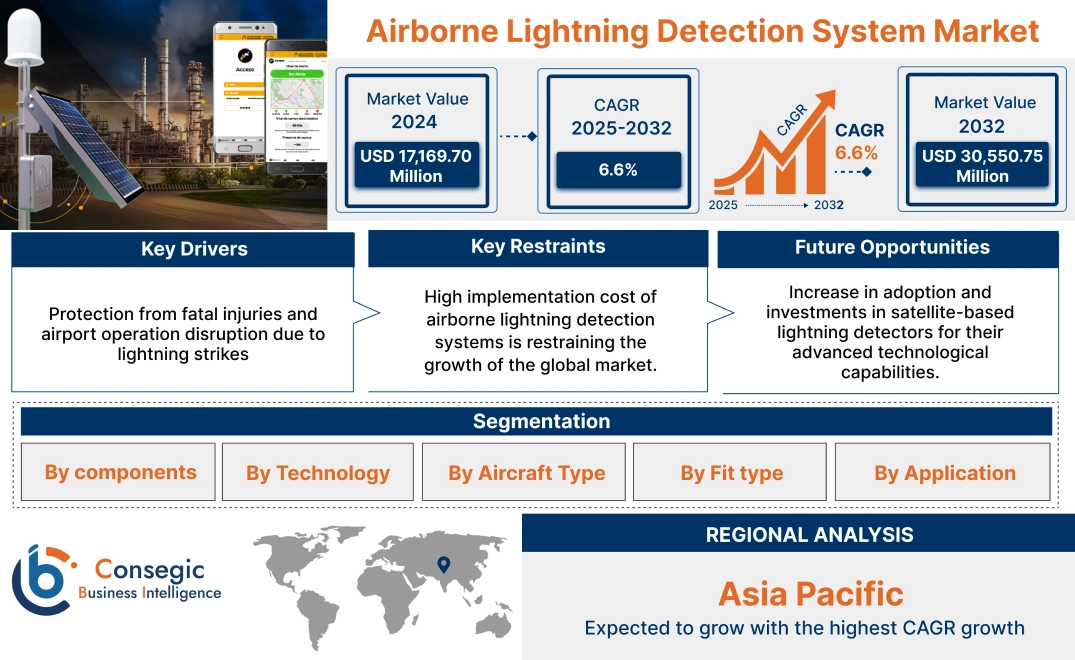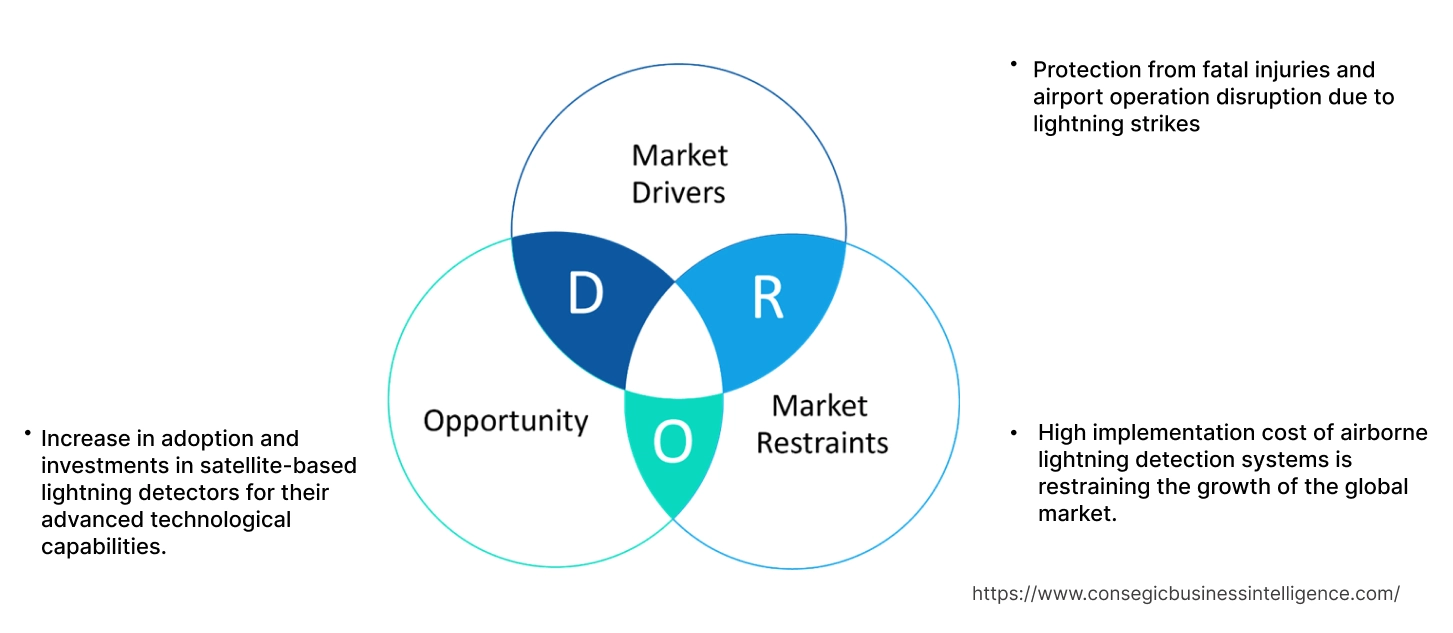- Summary
- Table Of Content
- Methodology
Airborne Lightning Detection System Market Size:
Airborne Lightning Detection System Market Size is estimated to reach over USD 30,550.75 Million by 2032 from a value of USD 17,169.70 Million in 2024 and is projected to grow by USD 18,328.65 Million in 2025, growing at a CAGR of 6.6% from 2025 to 2032.
Airborne Lightning Detection System Market Scope & Overview:
Airborne lightning detection system is used for detecting light produced by thunderstorms, which is hazardous to aircraft operations, airport operations, and the provision of air traffic services. Additionally, these lightning detection systems protect generators, fuel valves, and electrical distribution systems. Moreover, lightning detection systems help in reducing the severity of strikes, helping to prevent potential damage to vehicles and infrastructure.
Key Drivers:
Protection from fatal injuries and airport operation disruption due to lightning strikes
Lightning strikes wreak havoc on airports, causing minor to substantial destruction worth millions of dollars, and have the potential to disrupt airport operations. Additionally, lightning strikes have damaged buildings, communications equipment, and airfield electrical systems, and struck passengers and employees. Furthermore, lightning warning systems detect electrical activity in the atmosphere and send an alert based on the energy detected, a more accurate indicator of a lightning strike. The system notifies the public in approximately 20 minutes before a lightning strike within a two-mile radius.
- For instance, Biral’s BTD-200 is an expandable lightning warning system, with a 22-mile (35 km) detection range. The product’s advanced technology is currently used as airports aviation-grade lightning detection systems.
Thus, the aforementioned factor is driving the growth of the airborne lightning detection system market.
Key Restraints:
High implementation cost of airborne lightning detection systems is restraining the growth of the global market.
A major drawback in the airborne lighting detection market is the elevated cost of acquisition and maintenance. These systems including aircraft and UAVs, are costly to acquire and necessitate significant investments in infrastructure, training, and upkeep. The operational expenses related to these systems, including fuel, repairs, and upgrades, can be considerable for many organizations, especially in the public sector and smaller businesses. This financial strain hinders the adoption and implementation of airborne surveillance solutions, hence impeding the growth of the global airborne lightning detection system market.
Future Opportunities :
Increase in adoption and investments in satellite-based lightning detectors for their advanced technological capabilities.
The satellite lightning data will provide persistent severe weather observations of the Western Hemisphere, improving storm analysis and prediction. Additionally, the investment by NASA such as the next-generation GeoXO Lightning Mapper (LMX) used to detect, locate, and measure the intensity, duration, and extent of lightning flashes is also expected to drive the airborne lightning detection system market trends.
- For instance, in September 2024, NASA awarded Lockheed Martin for building the next-generation GeoXO Lightning Mapper (LMX), the baseline contract is valued at approximately USD 297 million.
Thus, the increasing investments in building next-generation lighting detection instruments are propelling the airborne lightning detection system market size.
Airborne Lightning Detection System Market Segmental Analysis :
By Component Type:
Based on the component type, the market is segmented into sensors, antennas, data processing units, and communication systems.
Trends in the Component Type:
- The capability of sensors to detect the presence of all forms of lightning out to a range of 35km (22 miles).
- Increasing demand for multi-function displays (MFDs) and uplinked weather information, aviators can choose different routes to avoid lightning and the storms they accompany.
The sensors segment accounted for the largest revenue share as well as for the highest CAGR during the forecast period.
- Lightning detection system sensors are useful tools for monitoring and mitigating the risks associated with lightning strikes.
- These sensors generate real-time data for early alerts, lightning reports, storm detection, and incident investigations.
- Lightning sensors detect radio frequency generated from lightning strikes, it also classifies cloud lightning and cloud-to-ground lightning.
- Moreover, these sensors detect both visible and high energy invisible electromagnetic and electrostatic charges indicating turbulent activity over longer distances.
- For instance, Honeywell’s LSZ-860 lightning sensor detects areas of lightning activity in a 200-nautical mile radius around the aircraft.
- Thus, based on the analysis, the capabilities of sensors to perform various real-time operations are driving the airborne lightning detection system market growth.
By Technology Type:
Based on the technology type, the market is segmented into radio frequency detection, electro-optical detection, and satellite-based detection.
Trends in the technology Type:
- The trend of Radio Frequency Sensors for detecting radio-frequency emissions from lightning that are in the very high frequency (VHF; 30–300 MHz) and high frequency (HF; 3–30 MHz) range.
- Electro-optical sensors come with many advantages such as small and lightweight, high sensitivity, reliable functioning, and wide dynamic range.
The radio-frequency detector dominated the target market and accounted for the 47.99% revenue share in 2024
- Radio frequency detectors capture electromagnetic emissions using antennas, enabling the identification of lightning activities.
- The radio frequency-based airborne lightning detectors provide real-time data to pilots enhancing flight safety by helping them avoid hazardous weather conditions.
- For instance, Strike Finder is used for detecting radio signals radiated from a vertical electrical discharge (lightning strike), which may be hundreds of miles away.
- Therefore, the capability of RF to give information about lightning strike from hundreds of miles away is driving the airborne lightning detection system market expansion.
The satellite-based detector is expected to register the highest CAGR over the forecast period.
- Satellite-based lightning detection has advantages such as wide observation range, and high observation angle, and is not subject to ground conditions.
- Satellite-based lightning systems detect total lightning over vast geographic areas, both day and night, with near-uniform detection efficiency.
- Emissions in the high radio-frequency range (e.g., VHF) and optical signals can be detected from satellite-based sensors, whose design and operating characteristics are dictated by the field of view and the orbital characteristics of the satellite platform.
- For instance, The Geostationary Lightning Mapper (GLM) is a satellite-borne single channel, a near-infrared optical transient detector capable of providing lightning detection at a rate never before obtained from space.
- Thus, the ability of satellite-based detector to detect lightning strikes from miles away is propelling the airborne lightning detection system market growth.
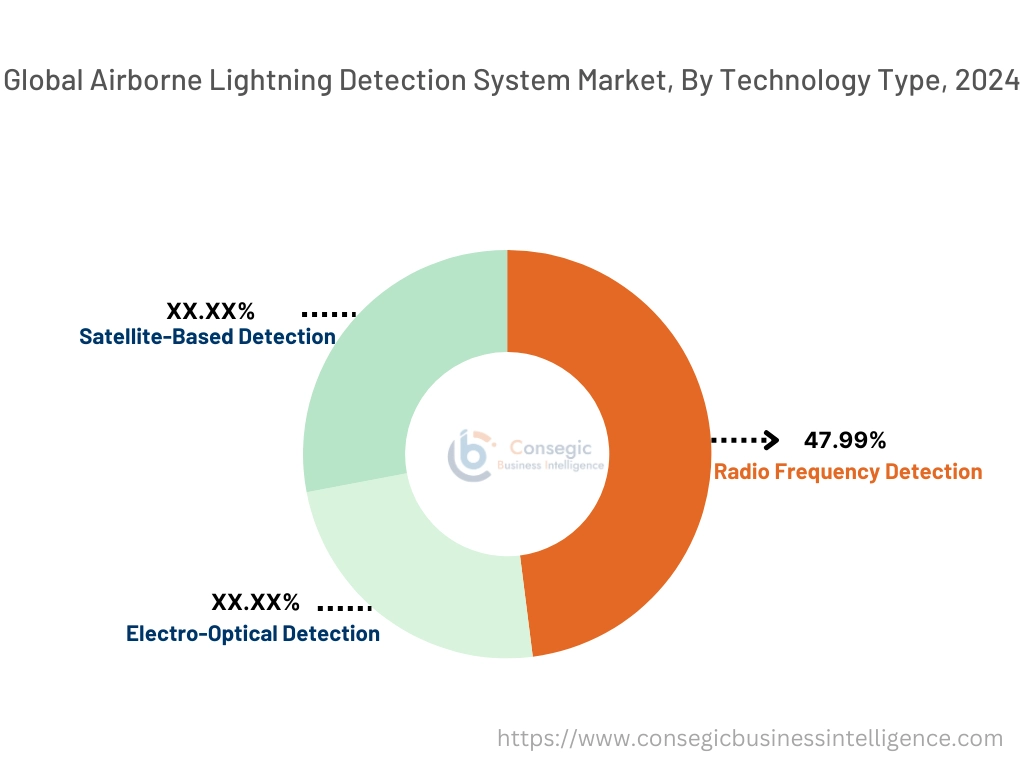
By Aircraft Type:
Based on the aircraft, the market is segmented into fixed-wing, rotary-wing, and UAV.
Trends in the application:
- The increasing trend of integrating lightning detection system with modern fixed-wing aircrafts.
- Cargo planes in regions prone to thunderstorm, are adopting these systems to protect valuable goods.
Fixed wing accounted for the largest revenue in the year 2024 as well as registered for fastest CAGR during the forecast period.
- Fixed-wing aircrafts are equipped with sensors that detect electromagnetic emissions generated by lightning strike.
- The integration of radio frequency detectors in fixed wing aircraft for locating the exact position of lightning strike by analysing the RF emission.
- Fixed-wing aircraft are required to comply with strict international safety standards, such as FAA and EASA regulations.
- Fixed-wing aircraft frequently operate on long-haul routes, exposing them to diverse weather conditions where lightning detection systems are critical.
- Thus, as per the analysis, the extensive use of fixed-wing aircrafts in adverse weather condition is propelling the airborne lightning detection system market demand.
By Fit Type:
Based on the aircraft, the market is segmented into linefit, and retrofit
Trends in Fit type:
- Regulatory bodies and aviation authorities are encouraging linefit installations to improve aviation safety standards.
- Retrofitting older aircrafts with modern lightning detection systems significantly enhances their safety, especially in regions with frequent thunderstorms.
Linefit accounted for the largest revenue in the year 2024 as well as registered for fastest CAGR during the forecast period.
- Aircraft manufacturers are increasingly incorporating ALDS as standard equipment in new aircraft models and this approach enhances flight safety from the start.
- Modern ALDS systems are designed to seamlessly integrate with existing aircraft avionics suites, providing a more comprehensive and user-friendly experience for pilots.
- Installing lightning detection systems during production is more cost-effective and efficient compared to retrofitting as it avoids labor.
- According to the analysis in aviation sector, the growing awareness regarding adversities happening due to weather conditions is driving the airborne lightning detection system market demand.
By Application:
Based on the application, the market is segmented into commercial aviation and military aviation
Trends in the application:
- Commercial airlines prioritize passenger safety with increasing investments in lightning detection systems to prevent lightning-related incidents.
- The growing global air travel industry and rising orders for new commercial aircraft drive the adoption of lightning detection systems.
Commercial Aviation accounted for the largest revenue in the year 2024
- Commercial aviation accounted for largest segment as regulatory authorities mandate advanced safety systems, including lightning detection to protect passengers.
- Airlines prioritize reliable lightning detection systems to ensure safe operations in regions prone to thunderstorms.
- The development of e-commerce and global trade has increased the use of cargo aircraft, which require lightning detection systems for safe operations in adverse weather.
- Thus, based on the airborne lightning detection system market analysis, increasing air traffic and government regulations is driving the airborne lightning detection system market size.
Military aviation is expected to register the highest CAGR over the forecast period
- Lightning detection improves situational awareness allowing military pilots to avoid severe weather that could compromise missions.
- Many nations are increasing defense spending, allocating funds to modernize their fleets and incorporate advanced safety and navigation technologies.
- Rising demand for next-generation fighter jets, transport aircraft, and surveillance planes is driving the integration of advanced lightning detection systems.
- Thus, as per the airborne lightning detection system market analysis, the growing adoption of lightning detection systems for safety and efficiency in military sector is driving the airborne lightning detection system market opportunities.
Regional Analysis:
The global market has been classified by region into North America, Europe, Asia-Pacific, MEA, and Latin America.
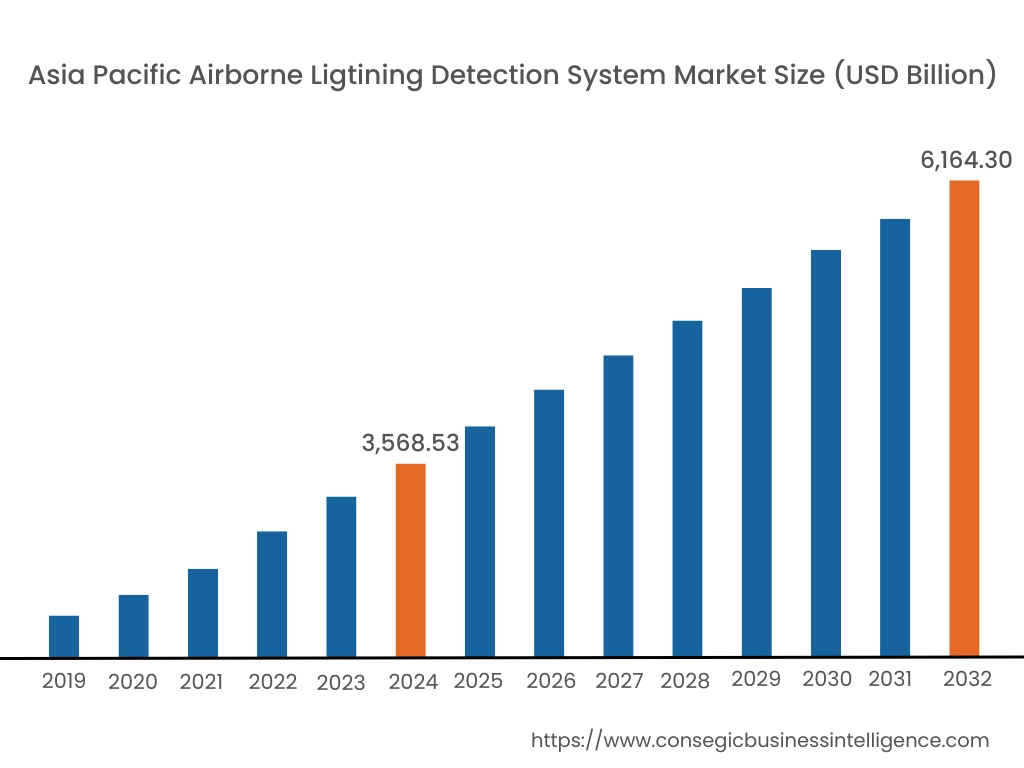
Asia Pacific is estimated to reach over USD 6,164.30 Million by 2032 from a value of USD 3,568.53 Million in 2024 and is projected to grow by USD 3,784.13 Million in 2025. Out of this, China accounted for the maximum revenue share of 30.39%.
- Asia Pacific holds the largest airborne lightning detection system market share for aircraft lightning protection compared to other regions, primarily due to the heightened purchasing power in the China concerning military and trade requirements. Various statistics indicate a notable increase in air travel and air traffic control within the United States. Many commercial airlines have announced intentions to acquire new aircraft and expand their flight services. These developments in the commercial sector significantly contribute to the aviation lightning protection industry. Furthermore, military procurement also bolsters the expansion of the aviation power sector.
- Conversely, the rising levels of international aviation production, driven by continually increasing demand, present substantial opportunities for the aviation protection sector in the forecast period.
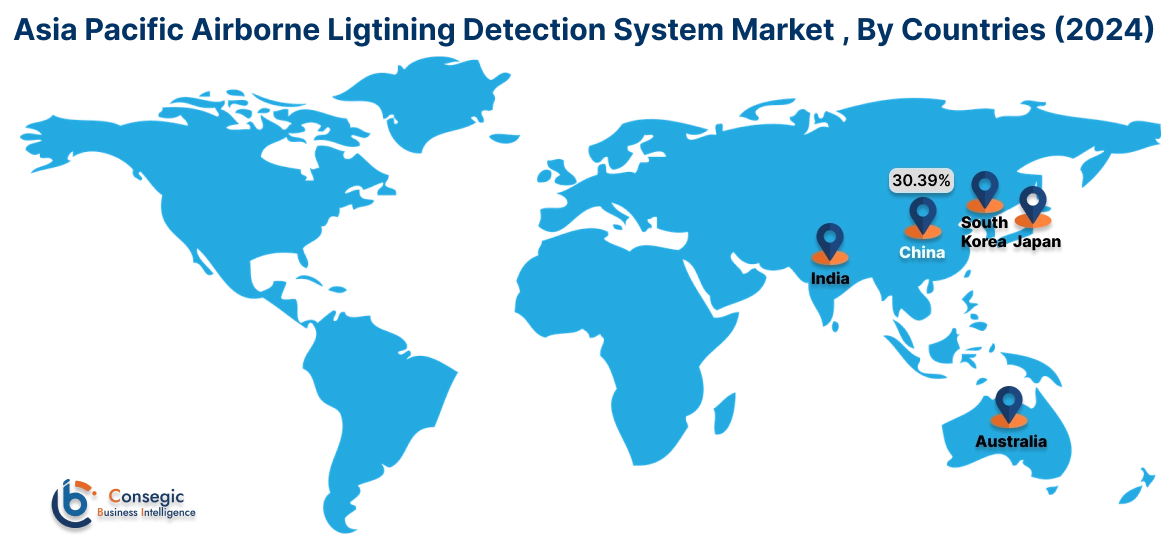
- The North America region is dominating due to the existence of key market players, strong regulatory frameworks, and the increasing adoption of advanced aviation technologies. Moreover, regions growing investment in research and development is contributing to its adoption within the North America region Airborne Lightning Detection System market trends. Furthermore, the continued adoption of AI and machine learning across various industries, and further integration of IoT devices expected to open new prospects and help in airborne lightning detection system market expansion.
- For instance, Honeywell’s IntuVue RDR-7000 Weather Radar System gives commercial aviation and helicopter pilots the clear and timely information helps in operational costs savings by reducing the delays & downtime caused due to hailstorm, weather incidents and windshears.
As per the analysis, Europe regions growth relies heavily on airborne lightning detection system for enhanced safety and operational efficiency. Advancements in technology and strategic investments play crucial roles in driving Europe’s airborne lightning detection system market share. Latin America is experiencing significant growth in their aviation industry, modernization of existing aircraft fleets present lucrative airborne lightning detection system market opportunities. The aviation sector in MEA region is witnessing steady growth, supported by investments in infrastructure development. Moreover, these advancements is expected to increase as it prioritizes airlines safety measures.
Top Key Players and Market Share Insights:
The market is highly competitive with major players providing products to the national and international markets. Key players are adopting several strategies in research and development (R&D), product innovation, and end-user launches to hold a strong position in the market. Key players in the Airborne Lightning Detection System industry include-
- L3 Technologies (US)
- Elbit System (ISRAEL)
- Aselsan (Turkey)
- Avidyne (US)
- Northrop Grumman (US)
- BAE Systems (UK)
- Honeywell International (US)
- Raytheon (US)
- Cobham (France)
- Astroseal Products Manufacturing (US)
Recent Industry Developments :
Partnerships & Collaboration:
- Airborne Lightning Observatory for Fly’s Eye GLM Simulator (FEGS) and Terrestrial gamma-ray flashes (ALOFT) field campaign collaborated with NASA Armstrong’s ER-2 aircraft following its safe return from a mission on July 24.
Airborne Lightning Detection System Market Report Insights :
| Report Attributes | Report Details |
| Study Timeline | 2019-2032 |
| Market Size in 2032 | USD 30,550.75 Million |
| CAGR (2025-2032) | 6.6% |
| By Components |
|
| By Technology |
|
| By Aircraft Type |
|
| By Fit type |
|
| By Application |
|
| By Region |
|
| Key Players |
|
| North America | U.S. Canada Mexico |
| Europe | U.K. Germany France Spain Italy Russia Benelux Rest of Europe |
| APAC | China South Korea Japan India Australia ASEAN Rest of Asia-Pacific |
| Middle East and Africa | GCC Turkey South Africa Rest of MEA |
| LATAM | Brazil Argentina Chile Rest of LATAM |
| Report Coverage |
|
Key Questions Answered in the Report
How big is the Airborne Lightning Detection System market? +
Airborne Lightning Detection System Market Size is estimated to reach over USD 30,550.75 Million by 2032 from a value of USD 17,169.70 Million in 2024 and is projected to grow by USD 18,328.65 Million in 2025, growing at a CAGR of 6.6% from 2025 to 2032.
Which is the fastest-growing segment in the Airborne Lightning Detection System market? +
Sensors segment is experiencing the most rapid growth in the market.
What specific segmentation details are covered in the Airborne Lightning Detection System report? +
The Airborne Lightning Detection System report includes specific segmentation details for the component type, technology type, aircraft type, fit type, application, and region.
Who are the major players in the Airborne Lightning Detection System market? +
The key participants in the market are L3 Technologies (US), Elbit System (ISRAEL), BAE Systems (UK), Honeywell International (US), Raytheon (US), Cobham (France), Astroseal Products Manufacturing (US), Aselsan (Turkey), Avidyne (US), Northrop Grumman (US) and others.
